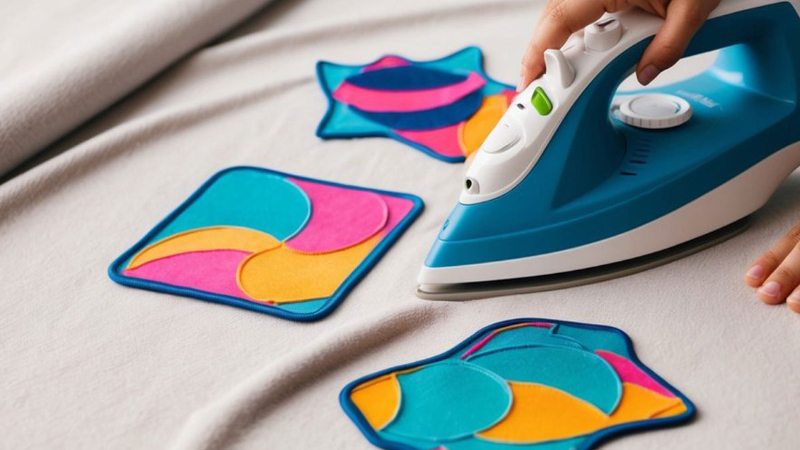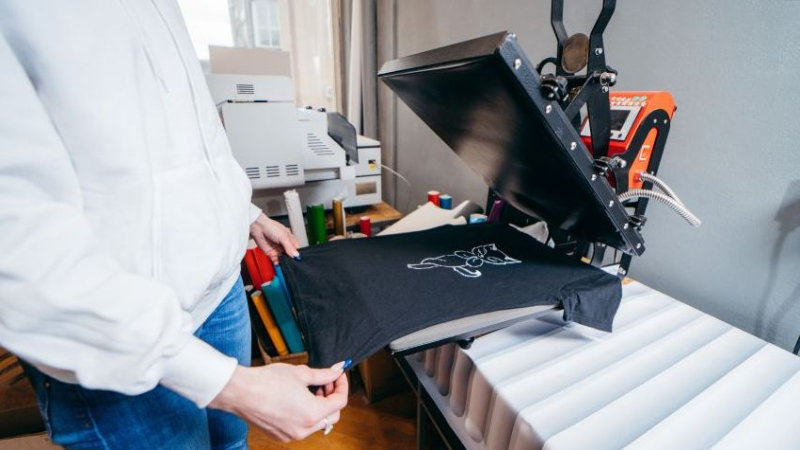Iron on Patches to Polyester: A Safe and Easy Guide – MyPackLove
Personalizing polyester clothing and accessories is a popular trend but applying iron-on patches to this fabric type can be tricky. Many individuals, crafters and businesses worry about heat damage and achieving a secure bond. This guide addresses the common pain points associated with applying iron-on patches to polyester. We’ll equip you with the knowledge and confidence to personalize your polyester items without fear of damage. Let’s start!
1. Understanding Iron-on Patches and Polyester
1.1 What are Iron-on Patches?
Iron-on patches are convenient. They come in various types including embroidered patches known for their texture and detail and printed patches offering vibrant colors and designs. Custom patches allow for personalized expression, branding or clothing repair. Choosing from various patch materials is key to ensuring a successful application and longevity.
Embroidered patches provide a three-dimensional texture and often a higher perceived value. Printed patches boast bright, crisp designs. These patches offer a relatively easy application method for various uses from clothing repair to decorative enhancements. The types of patches available are quite extensive, allowing for a wide array of design options.

1.2 Working with Polyester Fabric
When working with polyester, it’s important to remember that this synthetic fabric has unique characteristics that can affect how iron-on patches are applied. Polyester’s smooth surface, while often desirable, can sometimes make it harder for adhesives to bond effectively.
Furthermore, polyester is sensitive to heat, requiring a more careful approach compared to natural fibers. Understanding this heat sensitivity is crucial to avoid damaging the fabric during the patch application process. Because polyester is synthetic, it generally needs lower heat settings than fabrics like cotton.
Applying too much heat can lead to melting or scorching, causing damage that can’t be reversed. Therefore, it’s always a good idea to test the iron’s heat setting on an inconspicuous area of the garment first, perhaps on an inside seam or hem.
This allows you to find the right temperature without risking damage to a visible part of the item. Taking care with fabrics like polyester is essential for ensuring your clothes last longer and continue to look their best.
2. Materials You’ll Need
2.1 Choosing the Right Patch
When it comes to successfully applying patches to polyester, choosing the right patch is a crucial first step. Not all patches are created equal, and for polyester specifically, you’ll want to consider a few key factors. There are various types of patches available, but some popular choices for polyester include embroidered patches and printed patches.
Embroidered patches are known for their durability and the raised texture they bring to your garment, adding a tactile element to the design. Printed patches, on the other hand, are excellent for designs that require a wide range of vibrant colors and intricate details.
For polyester fabrics, it’s often best to look for patches that are specifically designed or recommended for use on synthetic materials. These patches are typically made to withstand the lower heat settings that polyester requires during application and have adhesives formulated to bond well with the smooth surface of polyester.
Before you proceed with applying any patch, always take a moment to carefully check the patch’s packaging or any included care instructions. This information will usually tell you if the patch is suitable for polyester and provide guidance on the correct application method.
Choosing the right adhesive patch from the start is a key factor in ensuring that your patch not only adheres properly but also lasts for a long time, maintaining the quality and appearance of your customized clothing. Investing a little time in selecting the appropriate patch can make a significant difference in the final outcome.

2.2 Essential Tools and Supplies
To achieve the best results, gather essential tools: a dry iron is sufficient for small patches. A pressing cloth or parchment paper protects both the patch and the polyester fabric from direct iron contact. An ironing board provides a stable and even surface during application. A heat press machine offers a more consistent heat application and is recommended for larger patches.
3. Step-by-Step Guide to Applying Iron-on Patches to Polyester
3.1 Preparing Your Garment
Before applying the patch, thoroughly clean the polyester garment to remove any dirt, oil or residue that could interfere with adhesion. Air dry the garment completely; ensure it’s completely dry before proceeding to prevent uneven heat distribution. Preparing the fabric for patching involves making sure the area is clean, dry and smooth.
Besides, you can use a mild detergent and avoid harsh chemicals. Thorough drying is essential to prevent steam from interfering with the heat transfer process. Cleaning polyester effectively paves the way for a smooth application.

3.2 Positioning the Patch
Carefully position the patch on the desired area of the polyester garment. Ensure proper alignment and centering. For more complex designs or delicate fabrics, pinning the patch in place before applying heat provides extra security and prevents shifting during the process. Precise placement ensures a neat and professional finish.

3.3 Applying Heat with an Iron
Set your iron to a low to medium setting; avoid high heat to prevent scorching the polyester. Place a pressing cloth or parchment paper over the patch to protect the fabric. Apply even pressure using a circular motion and maintain contact for 30-60 seconds. Avoid sliding the iron; lifting and repositioning are preferred to avoid damage to the fabric. Applying even pressure is key for successful adhesion.
You can use a gentle circular motion and avoid harsh pressure or prolonged contact in one spot. The pressing cloth protects both the garment and the patch from direct heat and helps with consistent heat distribution. Ironing techniques play a crucial role in successful patch applications.

3.4 Using a Heat Press (Alternative Method)
A heat press machine provides a safer and more consistent application method, especially for larger patches. Consult your heat press machine’s manual for recommended settings; generally, a lower temperature and moderate pressure for a shorter duration (15-30 seconds) is sufficient for polyester. Adjust the temperature and pressure settings to your patch and polyester garment; different patches may require slightly different application. Time settings for heat press can vary depending on your heat press and patch type.

4. Troubleshooting and Tips for Best Results
4.1 Patch Not Sticking Properly
If your patch isn’t sticking properly, several factors may be at play. Insufficient heat, improper cleaning of the garment’s surface or using an unsuitable patch type can all contribute to adhesion issues. Reapply heat using the recommended settings, ensuring the surface is clean and dry. If the problem persists, consider using a stronger adhesive or hand-sewing the patch for a more secure hold. Patch peeling often indicates insufficient adhesion.
4.2 Removing a Misplaced Patch
Mistakes can happen, and sometimes an iron-on patch might end up slightly off-center or not quite where you intended. If you find yourself needing to remove a misplaced patch from polyester, it’s important to proceed carefully to avoid damaging the fabric.
One effective method is to gently apply heat to the patch using a low-temperature iron. The warmth can help to soften the adhesive, making it easier to lift the patch. Apply the iron for a few seconds, then try to gently peel up an edge of the patch.
Work slowly and patiently, reheating as needed if the patch is still firmly stuck. If the patch is proving difficult to remove cleanly, or if any adhesive residue remains afterwards, you might consider using a specialized adhesive remover.
However, it’s crucial to test any remover in a hidden area of the garment first, such as an inside seam, to ensure it doesn’t discolor or damage the polyester fabric. It’s also worth noting that issues like a patch not sticking initially and a patch peeling off after application are distinct problems, often requiring different approaches to resolve.
A patch that doesn’t stick from the beginning might need more heat or pressure during the initial application, while a peeling patch could indicate insufficient initial adhesion or perhaps the wrong type of patch for the fabric.

4.3 Caring for Your Patched Garment
To prolong the life of your patched garment, follow these washing and drying instructions: wash the item inside out in cold or lukewarm water using a mild detergent. Air-dry the garment to avoid the high heat of a dryer which may damage the patch or the polyester fabric itself. Air drying helps to maintain the quality and color of the patch and the garment. Patch care is crucial for maintaining the quality and longevity of your repair.
5. FAQs about Iron-on Patches on Polyester
5.1 Can I use steam when ironing on patches to polyester?
No, steam is not recommended when ironing patches onto polyester. The moisture from steam can distort the polyester fibers, resulting in uneven adhesion and potentially damaging the fabric. A dry iron provides more consistent heat transfer and prevents unwanted warping or discoloration of the material.
5.2 What if my patch starts to peel off after washing?
If your patch starts to peel off after washing you can try reapplying heat using a dry iron at a low to medium setting. Cover the patch with a cloth to protect the fabric. If peeling persists, hand-sewing the patch provides a more permanent and durable solution.
5.3 What type of adhesive is best for polyester patches?
Heat-activated adhesives specifically designed for fabrics are the best choice for polyester patches. These adhesives are formulated to bond effectively with synthetic materials like polyester, providing a durable and reliable hold. Ensure the patch’s instructions specify compatibility with polyester.
5.4 Can I iron on patches to all types of polyester?
While most polyester fabrics are suitable for iron-on patches, you always test the heat settings on a hidden area first. Delicate or treated polyesters may be damaged by heat. Use caution with specialty fabrics; some treatments may react poorly to heat.
5.5 Are embroidered patches better than printed patches for polyester?
Both embroidered and printed patches can work well on polyester but embroidered patches often offer superior durability and a more premium appearance due to their construction. Printed patches can still be effective but may be less resistant to wear and tear over time. The best option depends on the desired aesthetic and longevity.
6. Packlove – Providing service for Custom Patches
Packlove provides comprehensive custom patch services to individuals. We offer a range of design options, material choices and printing techniques to create high-quality, durable patches tailored to your exact specifications. Our expertise ensures professional results from initial design concepts to final product delivery. We handle every aspect of your patch creation, making the process seamless and efficient.
Our skilled team leverages years of experience in design and printing to produce exceptional custom patches. We pay close attention to detail and employ state-of-the-art equipment to achieve consistent, high-quality results. We work with various materials including woven, embroidered and printed patches to fulfill your needs and vision.
For inquiries about our custom patch services, contact us via phone at +84 363615867, email at infopacklove@gmail.com or visit our website at https://Packlove.com/. We welcome the opportunity to assist you in creating the perfect custom patches for your needs.
Read more:
- Iron on Patches to Polyester: A Safe & Easy Guide – Packlove
- How to Stick Patches on Backpacks: Easy Guide for All Types
- How to Make Patches: DIY Embroidered & Iron-On Patch Guide
Mastering the art of applying iron-on patches opens up a world of creative possibilities. Whether you are repairing damaged clothing or creating unique customized items, this guide provides the information needed for success. This process is a valuable skill for both personal projects and small businesses. For high-quality, custom-designed patches and a wide range of related products and services, explore the options available at Packlove.













